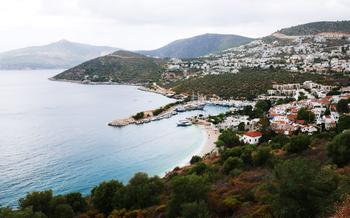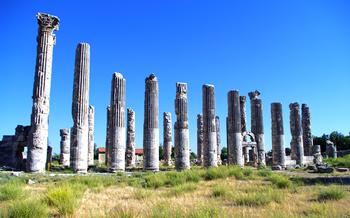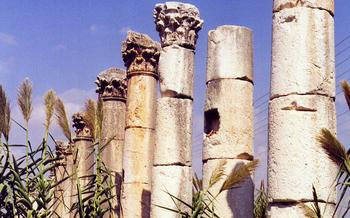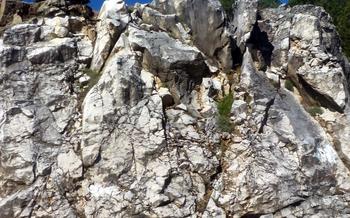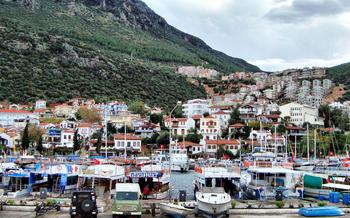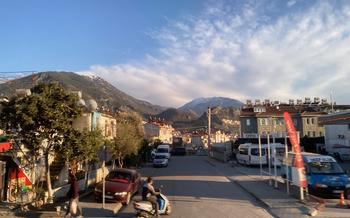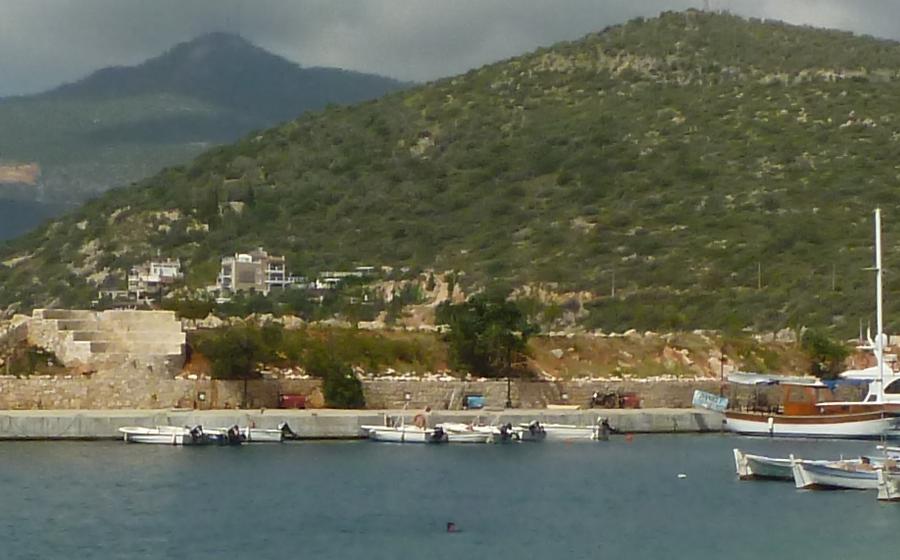
Pinara Ancient City
- Historical Significance
- Getting There
- Entrance Fees and Hours
- Exploring the City
- The Theater
- Rock Tombs
- Agora: The Marketplace and Gathering Place
- Temple of Zeus
- Temple of Artemis
- Acropolis
- Lycian Sarcophagi: Intricate Masterpieces of Funerary Art
- City Walls
- Nature's Beauty
- Local Cuisine
- Insider Tip: Explore the Hidden Waterfalls
Historical Significance
Pinara, an ancient Lycian city of great significance, invites you to delve into its rich past. Once a prominent religious center, it boasts impressive religious structures that stand as testaments to Lycian devotion. Explore the ruins of temples dedicated to Zeus and Artemis, where locals once sought divine favor. Admire the intricate rock tombs carved into the surrounding cliffs, serving as eternal resting places for the Lycian elite.
Pinara's architectural remains offer a glimpse into Lycian culture and craftsmanship. The well-preserved theater, with its impressive seating capacity, hosted captivating performances and public gatherings. The agora, the city's bustling marketplace, was a hub of commerce and social interaction. As you wander through the ancient streets, let your imagination transport you back in time, envisioning the daily lives of the Lycians who once called this place home.
Getting There
Reaching Pinara Ancient City from Kalkan is a breeze, offering multiple options for travelers. Public transportation provides a convenient and affordable way to get to the site. Buses depart regularly from Kalkan's main bus station and take approximately 45 minutes to reach Pinara. Guided tours are another excellent option, as they often include transportation, entrance fees, and a knowledgeable guide to enhance your experience. The distance between Kalkan and Pinara is roughly 25 kilometers, and self-drive routes are available for those who prefer the flexibility of exploring at their own pace. Rental cars can be easily arranged in Kalkan, and the drive offers scenic views of the surrounding countryside.
Entrance Fees and Hours
Visiting Pinara Ancient City requires an entrance fee, which is typically a standard rate for all visitors. The fee contributes to the preservation and maintenance of the site. It is advisable to carry cash as card payments may not be accepted.
The operating hours of Pinara Ancient City vary depending on the season. During the summer months (April to October), the site is generally open from 8:00 AM to 7:00 PM. In the winter months (November to March), the hours may be shorter, typically from 8:00 AM to 5:00 PM. It is recommended to check the official website or local tourism information centers for the most up-to-date information on entrance fees and operating hours.
Exploring the City
Begin your exploration of Pinara Ancient City at the entrance, where a map and information boards provide an overview of the site. From there, follow the well-marked paths that lead you through the ruins. The first stop is the theater, an impressive structure that has been partially restored. Admire its well-preserved seating tiers and imagine the lively performances that once took place here.
Continuing along the path, you'll come across the agora, the bustling marketplace of ancient Pinara. Look for the remains of shops, colonnades, and a fountain. The agora was the center of daily life, where people gathered to buy and sell goods, socialize, and conduct business.
Next, head to the Temple of Zeus, dedicated to the patron god of Pinara. Although only a few columns and fragments remain, it's still possible to appreciate the grandeur of this once-important religious structure. From here, make your way to the Temple of Artemis, which was dedicated to the goddess of hunting and nature. While not as well-preserved as the Temple of Zeus, it's still an impressive sight.
Finally, climb up to the acropolis, the fortified upper city of Pinara. Here, you'll find the remains of city walls, towers, and other defensive structures. The acropolis offers stunning views of the surrounding countryside, making it a perfect place to end your exploration of this ancient city.
The Theater
At the heart of Pinara Ancient City lies a magnificent theater, a testament to the artistry and engineering prowess of the Lycians. With a seating capacity estimated to accommodate over 5,000 spectators, it served as a vibrant venue for theatrical performances, musical concerts, and civic gatherings. The well-preserved stage and orchestra pit hint at the lively cultural scene that once graced this ancient city. The theater's acoustics are remarkably intact, allowing visitors to experience the same auditory clarity that captivated audiences centuries ago. Step into the theater and let the spirit of ancient drama transport you back in time.
Rock Tombs
As you wander further into the ancient city, you'll be awestruck by the magnificent rock tombs carved into the towering cliffs that surround Pinara. These impressive structures served as burial chambers for the Lycian elite, showcasing their wealth and status.
The tombs, with their intricate facades and decorative elements, provide a glimpse into the artistry and craftsmanship of the Lycians. Admire the intricate carvings that adorn their entrances, depicting scenes from mythology, daily life, and the afterlife. Each tomb is unique, telling a different story about the individuals who were laid to rest within its walls.
Explore the interiors of these tombs, where you'll find spacious chambers adorned with frescoes and reliefs that offer insights into Lycian burial practices and beliefs. The tombs are not only architectural marvels but also valuable sources of historical information, shedding light on the lives and customs of this ancient civilization.
Agora: The Marketplace and Gathering Place
The agora, or marketplace, was the bustling hub of Pinara, where locals gathered to trade goods, exchange news, and socialize. It served as the city's commercial center, with shops and stalls lining its perimeter. Archaeologists have uncovered various structures within the agora, including a colonnaded walkway that provided shelter from the sun and rain.
The agora was not just a place of commerce; it also played a significant role as a social and political gathering place. Public meetings and assemblies were held here, where citizens discussed important issues affecting their community. The agora was a lively and vibrant space where people from all walks of life came together to interact and shape the life of the city.
Temple of Zeus
Amidst the ruins of Pinara, the Temple of Zeus stands as a testament to the city's devotion to its patron deity. Zeus, the king of the gods in Greek mythology, held a prominent position in Lycian religious beliefs. The temple's imposing architecture reflects the importance accorded to Zeus. Constructed in the classical style, the temple features a rectangular layout with a cella, or inner sanctum, where a statue of Zeus once stood. The exterior of the temple is adorned with intricate carvings and friezes depicting scenes from Greek mythology, showcasing the artistic prowess of the Lycians. The Temple of Zeus not only served as a religious center but also as a symbol of Pinara's power and prosperity, underscoring the deep connection between the city and its patron god.
Temple of Artemis
The Temple of Artemis stands as a testament to the religious devotion of the ancient Lycians. Dedicated to the goddess Artemis, who was revered as the protector of nature and hunting, the temple once served as a sacred sanctuary for worship and rituals. Although only ruins remain today, the temple's legacy lives on, echoing the spiritual beliefs and practices of a bygone era.
Acropolis
The acropolis of Pinara, perched atop a hill overlooking the ancient city, served as the fortified upper city during ancient times. Its strategic location provided a vantage point for defense and control. While much of the acropolis lies in ruins, visitors can still explore the remains of fortifications and structures that once stood within its walls.
The acropolis was the heart of Pinara's defense system, with sturdy fortifications encircling its perimeter. These fortifications included towers, ramparts, and gates, designed to protect the city from invaders. Visitors can still see sections of these fortifications, offering a glimpse into the city's defensive prowess.
Within the acropolis, various structures once stood, serving different purposes. Temples, administrative buildings, and storage facilities were likely among these structures, although their exact nature and functions remain uncertain due to the fragmentary nature of the remains.
Exploring the acropolis of Pinara is a journey into the city's past, where visitors can imagine the bustling activity that once took place within its walls. The stunning views from the acropolis, overlooking the surrounding countryside, add to the awe-inspiring experience of exploring this ancient city.
Lycian Sarcophagi: Intricate Masterpieces of Funerary Art
Pinara's Lycian sarcophagi are a testament to the artistry and craftsmanship of the ancient Lycians. Carved from solid stone, these impressive sarcophagi feature intricate carvings and iconography that provide valuable insights into Lycian funerary practices.
The sarcophagi depict a variety of scenes and motifs, often related to mythology, nature, and daily life. Lycian heroes, deities, and mythical creatures are commonly depicted, showcasing the rich mythology of the region. Animals such as lions, bulls, and eagles are also frequently featured, symbolizing strength, power, and the afterlife.
Beyond their artistic value, these sarcophagi offer a glimpse into the social status and beliefs of the Lycian elite. The elaborate carvings suggest the importance placed on death and the afterlife in Lycian culture. The sarcophagi also provide insights into their social hierarchy, with more elaborate and ornate carvings reserved for individuals of higher status.
City Walls
Pinara's impressive city walls stand as a testament to the city's strategic importance and defensive capabilities. Constructed from massive blocks of stone, the walls once encircled the entire city, providing protection from potential invaders. Several gateways, each featuring intricate carvings and inscriptions, allowed access to the city. These gateways served not only as defensive checkpoints but also as symbolic entrances, welcoming visitors and showcasing the city's grandeur. Exploring the remnants of the city walls offers a glimpse into the engineering prowess and architectural achievements of the ancient Lycians, who skillfully combined functionality with aesthetics in their urban design.
Nature's Beauty
As you explore the ancient city of Pinara, be sure to take in the breathtaking natural surroundings. Nestled amidst towering mountains and lush valleys, Pinara offers stunning vistas that will leave you in awe. The combination of historical ruins and natural beauty creates a truly unique and unforgettable experience.
For those who love the outdoors, there are plenty of opportunities for hiking and nature walks in the area. Take a leisurely stroll through the surrounding countryside, and you'll be rewarded with panoramic views of the Taurus Mountains and the Mediterranean Sea. The fresh air and tranquil atmosphere will help you unwind and connect with the natural world.
Whether you're a history buff, a nature lover, or simply someone looking for a unique and enriching experience, Pinara Ancient City has something to offer everyone. So come and explore this hidden gem, and let its rich history, stunning scenery, and warm hospitality captivate you.
Local Cuisine
After a day of exploring the ancient city, indulge in the flavors of traditional Turkish cuisine at local restaurants or eateries near Pinara. Savor the tantalizing aromas and vibrant colors of dishes like "meze," a selection of small appetizers served with fresh bread. Try the classic "köfte," grilled meatballs seasoned with herbs and spices, or "pide," a boat-shaped flatbread topped with various fillings. For a taste of local seafood, order "levrek" or "çipura," grilled sea bass or sea bream, freshly caught from the Mediterranean Sea. Complement your meal with a glass of "ayran," a refreshing yogurt drink, or "şalgam," a fermented turnip juice. Don't forget to end your culinary journey with a sweet treat like "baklava" or "künefe," flaky pastries filled with nuts and syrup.
Insider Tip: Explore the Hidden Waterfalls
Beyond the ancient ruins, Pinara offers a hidden natural gem—the cascading waterfalls of Pinara Gorge. Take a short hike along the gorge, following the sound of rushing water. As you approach, you'll be greeted by a series of stunning waterfalls, surrounded by lush greenery and towering cliffs. It's the perfect spot to cool off on a hot day, relax, and enjoy the tranquility of nature. Pack a picnic lunch and make a day of it, soaking in the beauty of this hidden oasis.
